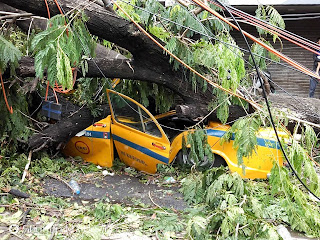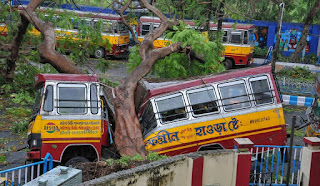Super Cyclonic Storm Amphan
Super Cyclonic Storm Amphan
According to
meteorology, cyclone is a large scale of mass that rotates around a strong
centre of low atmospheric pressure. It is characterised by strong winds,
thunderstorms and heavy rainfall. When a storm develops over the Indian Ocean
it is referred to as tropical cyclones or severe cyclonic storms. It was also the 3rd Super Cyclone that hit West Bengal
since 1582, after 1737 and 1833.
On 18 May, at approximately
12:00 UTC, Amphan reached its peak
intensity with 3-minute sustained wind speeds of 240 km/h (150 mph),
1-minute sustained wind speeds of 260 km/h (160 mph), and a
minimum central barometric pressure of
925 mbar (27.32 inHg). The storm began an eyewall replacement
cycle shortly after it reached its peak intensity, but the continued
effects of dry air and wind shear disrupted
this process and caused Amphan to gradually weaken as it paralleled the eastern
coastline of India. On 20 May, between 10:00 and 11:00 UTC, the cyclone
made landfall in West
Bengal. At the time, the JTWC estimated Amphan's
1-minute sustained winds to be 155 km/h (100 mph). Amphan rapidly
weakened once inland and dissipated shortly thereafter.Coastal areas in West
Bengal comprising East Midnapur, North 24 Parganas, South
24 Parganas, Kolkata, Hooghly and Howrah as well as Odisha were affected by the cyclone. It also caused
significant destruction in Bangladesh
Amphan is a severe
cyclonic storm that is set to hit the coast of West Bengal's Digha and Hatia
Islands of Bangladesh during the afternoon or evening of May 20. The tropical
cyclone had intensified into a super cyclonic storm between May 17 and 18,
according to IMD. At least 19 teams of National Disaster Response Force
(NDRF) have been deployed in West Bengal in view of the approaching
cyclone. The cyclone Amphan comes a year after cyclone 'Fani' on May 3,
2019 that claimed the lives of 64 people.
Army support has been called for,
NDRF and SDRF team has been deployed, railways, ports and most of the damaged
areas as the local workers unable to complete the work or because of proper skills
. In most of the areas of Kolkata, people suffered for food, electricity and
water. Damaged was so big, government couldn’t restore electricity and water
for 5 long days.
Cyclone Amphan,
hit West Bengal on
May 20 claiming 86 lives so far and affecting over 10 million
people in the eastern Indian state. The storm in West Bengal caused massive damage to
standing crops, thousands of trees were uprooted, and power and water supply
was interrupted in the state capital Kolkata.
Over 28% of
Sunderbans damaged in Cyclone Amphan, 16,000 trees were damaged in Kolkata. As
per Chief Minister 12,000 sq km forests had been “destroyed “. The Indian
Sunderbans , an area of South of the Dampier Hodges line, is spread over 9,630
sq km , of which the mangrove forest accounts for 4,236 sq km.




Comments
Post a Comment
If you have any suggestion , please let me know